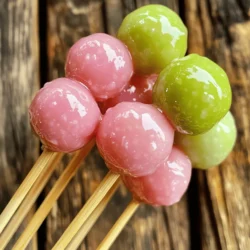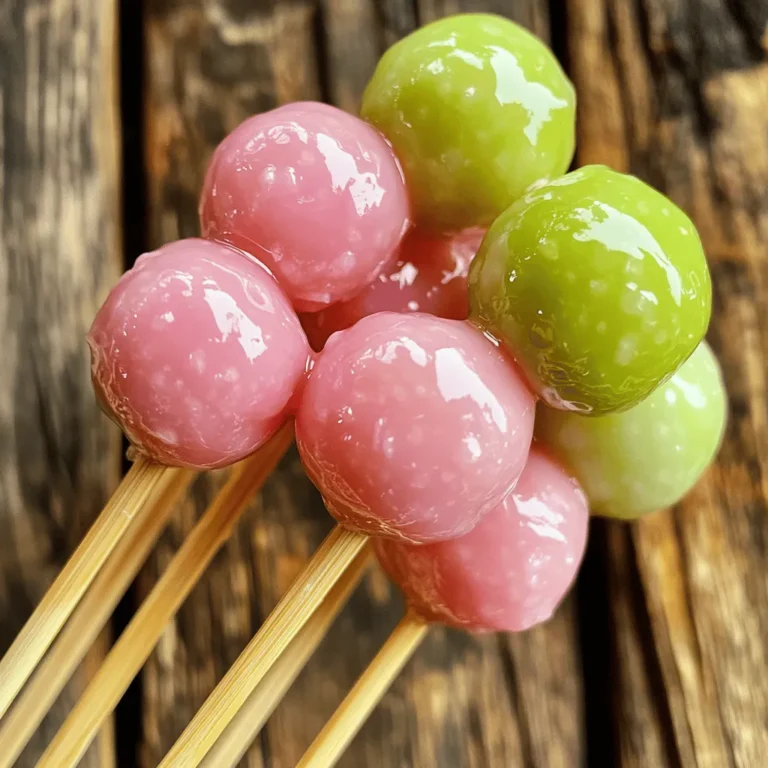Are you ready to make your own delicious dango? This Easy Dango Delight recipe breaks it down in simple steps. You’ll learn about the key ingredients, tools you need, and tips for perfecting each batch. Whether you want sweet or savory versions, I’ll guide you through variations and fun serving ideas. Let’s dive into the world of dango and treat yourself to a delightful snack you can share!
Ingredients
Key Ingredients for Easy Dango
To make Easy Dango, you need a few key ingredients. Here’s what you will need:
– 1 cup sweet rice flour (mochi flour)
– 1/3 cup granulated sugar
– 1/2 cup water
– A pinch of salt
These ingredients blend well to create a sweet and chewy treat that you will love.
Optional Flavoring Ingredients
You can add a twist to your dango with optional flavorings. Here are some ideas:
– Food coloring (pink or green for fun colors)
– Soy sauce or sweet soy glaze for dipping
These options let you customize your dango to fit your taste and style.
Tools and Equipment Needed
Having the right tools makes cooking easier. Here’s what you will need:
– Mixing bowl
– Slotted spoon
– Pot for boiling water
– Bamboo sticks (if you want to skewer the dango)
With these tools, you can prepare and enjoy your Easy Dango without hassle.Enjoy making this delightful treat!
Step-by-Step Instructions
Preparation of the Dough
To make the dough, start by mixing the sweet rice flour and sugar in a bowl. This mix is the base for your dango. Next, slowly add water while stirring. This helps the dough become smooth and thick. If you want to add color, put in a few drops of food coloring. Mix until the color spreads evenly. Let the dough rest for 10 minutes. This step makes it easier to shape.
Cooking the Dango
Bring a pot of water to a gentle boil. Take your dough and form small balls, about 1 inch wide. Gently drop the balls into the boiling water. Cook them for 5-7 minutes. You’ll know they’re done when they float. Use a slotted spoon to take them out and place them in cold water for 2 minutes. This stops the cooking. After that, drain the dango and let them cool.
Serving Suggestions
You can enjoy dango in many ways. For a classic touch, skewer the dango on bamboo sticks. This makes them easy to eat. If you like, dip them in soy sauce or sweet soy glaze. Both add a tasty twist. The dango can be served warm or at room temperature. They are perfect for any snack or dessert time.
Tips & Tricks
Common Mistakes to Avoid
When making dango, watch out for a few common mistakes.
– Too Much Water: Adding too much water can make the dough too sticky. Use the water slowly for the right texture.
– Boiling Too Long: If you boil the dango too long, they may become tough. Aim for 5-7 minutes until they float.
– Skipping the Rest: Let the dough rest for 10 minutes. This helps the texture and makes it easier to shape.
Enhancing Texture and Flavor
To make your dango even better, consider these tips:
– Use Sweet Rice Flour: This flour gives dango its unique chewy texture. Don’t substitute with regular flour.
– Food Coloring: Add a few drops of food coloring for fun. Pink or green colors make your dango pop!
– Glaze Options: Try a sweet soy glaze for a rich flavor. It pairs well with the chewy dough.
Presentation Ideas
Make your dango look nice on the plate:
– Skewering: Use bamboo sticks to skewer the dango. This adds a traditional touch.
– Colorful Layers: Layer dango of different colors on a plate. It looks inviting and fun.
– Garnishes: Add fresh fruit or mint leaves for a pop of color. This makes your dish even more appealing.

Variations
Colorful Dango Options
You can make your dango colorful and fun! Use food coloring to create bright shades. Pink and green are popular choices. Mix a few drops into your dough before cooking. This makes your dango look festive and appealing. You can even create a rainbow effect by using different colors for each ball. It’s a great way to impress friends and family!
Sweet vs. Savory Dango Recipes
Dango can be sweet or savory. Sweet dango often uses sugar and is served with sweet sauces. You can try a sweet soy glaze for a tasty treat. For savory dango, add salt or miso to the dough. This gives it a unique flavor. Pair savory dango with a soy sauce dip for a delicious snack. Each option offers a different taste experience.
Dipping Sauces for Dango
Dipping sauces add a special touch to your dango. Sweet soy glaze is a popular choice; it’s rich and sticky. You can also use plain soy sauce for a salty kick. If you like a hint of sweetness, mix soy sauce with sugar. This creates a great balance. Experiment with different sauces to find your favorite! Each dip enhances the dango’s flavor and makes it more enjoyable.
Storage Info
How to Store Leftover Dango
After you enjoy your dango, you may have some left. To store leftover dango, place them in an airtight container. This helps keep them fresh. If you have a glaze on them, it’s best to store them without the glaze. This way, the dango won’t get soggy. Keep the container in the fridge. The dango will last for about three days.
Reheating Dango for Best Results
When you’re ready to eat your stored dango, reheating is easy. You can steam them for a few minutes for the best taste and texture. If you don’t have a steamer, you can microwave them too. Place the dango on a microwave-safe plate. Add a damp paper towel on top. Heat for about 10-15 seconds at a time. Always check to make sure they are warm, not hot.
Freezing Dango for Future Use
Want to save dango for later? Freezing is a great option! First, let the cooked dango cool completely. Then, place them in a single layer on a baking sheet. Freeze them for about one hour. Once frozen, transfer them to a freezer-safe bag or container. Make sure to remove as much air as possible. You can freeze dango for up to one month. When ready to eat, just reheat them using the steaming method.
FAQs
What is Dango?
Dango is a Japanese sweet made from rice flour. It comes in small round shapes. People often enjoy it on a stick. Dango can be served plain or with toppings. You can find it in many flavors, like sweet or savory. It is a popular treat during festivals and special events.
Can I make Dango without sweet rice flour?
Yes, you can use regular rice flour. However, the texture will change. Sweet rice flour gives dango its chewy and soft feel. If you use regular flour, the dango may be less sticky. For the best results, I recommend using sweet rice flour. You can find it in most Asian grocery stores.
How do I achieve different textures in Dango?
To change the texture, try adjusting the water content. More water makes softer dango. Less water will create a firmer texture. You can also experiment with steaming instead of boiling. Steaming gives dango a different feel and taste. Adding ingredients like mashed sweet potatoes can also change the texture.
Making dango is simple and fun. We explored key ingredients, tools, and step-by-step instructions. You learned to prepare dough, cook it, and serve it well. Plus, we shared tips to avoid mistakes and enhance flavor. Don’t forget the colorful variations and sauces that make dango exciting!
In conclusion, dango offers endless possibilities. Enjoy experimenting with flavors and textures. Share your creations with friends and family to bring joy to your table. Your dango journey starts with the basics, but it can grow into something special.


